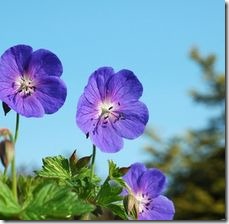In 2008, the Perennial Plant Association named Geranium rozanne Perennial Plant of the Year. This geranium grows clusters of small, violet-blue, saucer-shaped flowers that bloom from late spring until the end of the growing season. Rozannes need six to eight hours of sun every day and grow best in a well-drained soil with added compost. They make good companion plants for flowers that share their growing requirements, and they also benefit some vegetables, fruits and grasses.
Fruits
-
Grapes and geraniums make good companion plants because geraniums repel Japanese beetles that feed on grape leaves. Grapes survive moderate amounts of damage, but severe loss of foliage is a problem. Geraniums contain an ingredient that paralyzes Japanese beetles within 30 minutes of the beetles feeding. Although the beetles can recover within 24 hours, they’re usually killed by predators before recovering.
Flowers
-
According to the Perennial Plant Association, geraniums look good when partnered with Shasta daisies or hostas. Shasta daisies are easy for beginner gardeners to grow. They like fast-draining soil and lots of sun and water. In addition, they seldom have problems with insects or disease. Shasta daisies have white flowers with a yellow button center. Hostas are also easy to grow. Hostas can have blue, green, white or gold leaves of varying textures. Their lily-like flowers range from lavender to white and grow on spikes. Fragrant varieties of this plant prefer five or six hours of sun every day, while blue-leafed hostas need shade.
Vegetables
-
Geraniums repel green cabbage worms that bore into cabbage heads, causing them to decay. They also make good companion plants for corn, tomatoes, peppers and green beans because of their ability to repel Japanese beetles that attack those vegetables.
Grasses
-
Ornamental grasses don’t usually require a lot of care and there are many colors and textures from which to choose. They are more adaptable than other garden plants. Most ornamental grasses need about three to five hours of direct sun every day. Ornamental grasses don’t attract many pests. Spraying the grass with a stream of water can control aphids or mites. Sand lovegrass (Eragrostis trichodes) grows between 1 and 2 feet tall with pink flowers that turn golden between mid to late summer. Like geraniums, it likes well-drained soil and plenty of sun. Another grass that partners well with geranium rozanne is Pennisetum alopecuroides Little Honey, a dwarf grass with tinted pink foliage.


Deprecated: strpos(): Passing null to parameter #1 ($haystack) of type string is deprecated in /home/agriviek8Qv/agriviet.net/public_html/wp-includes/comment-template.php on line 2522